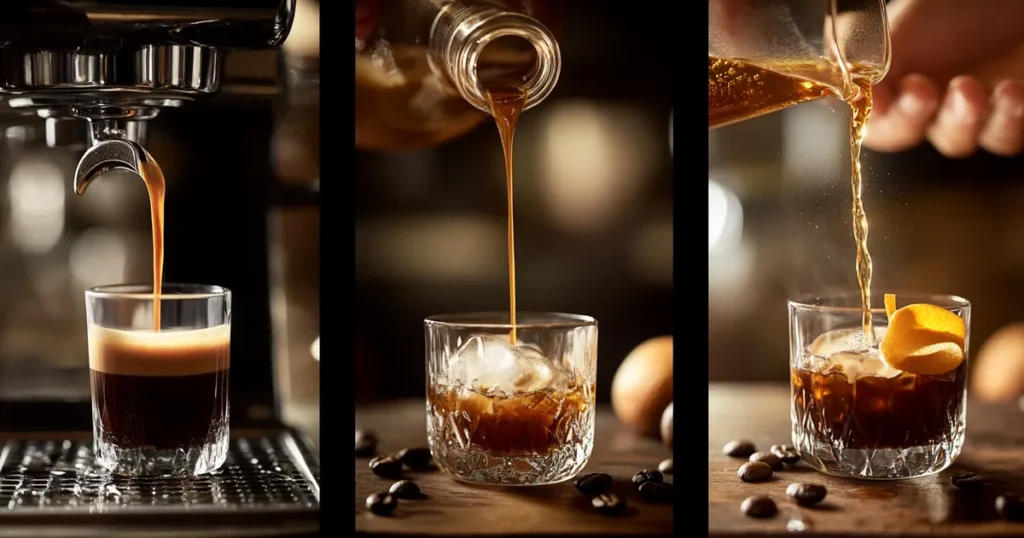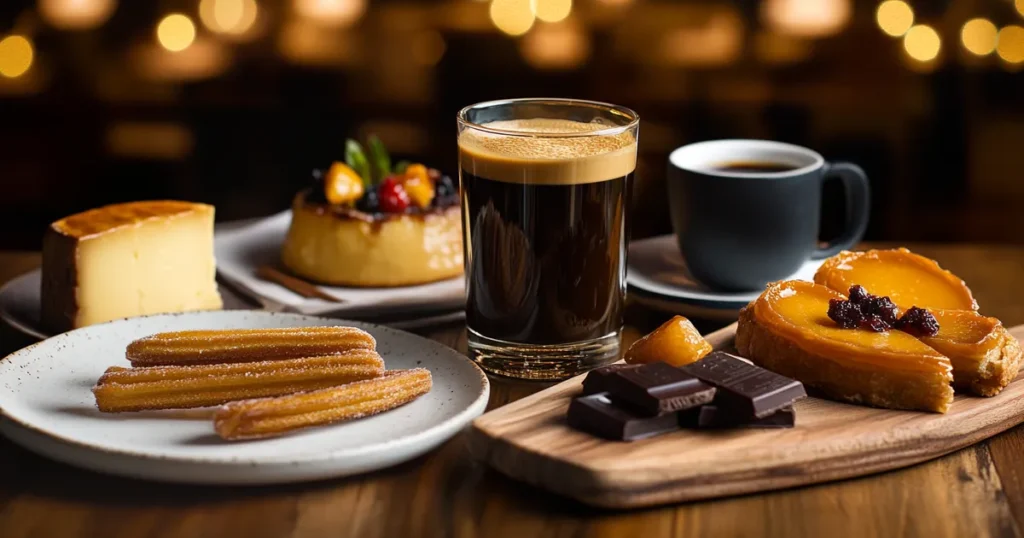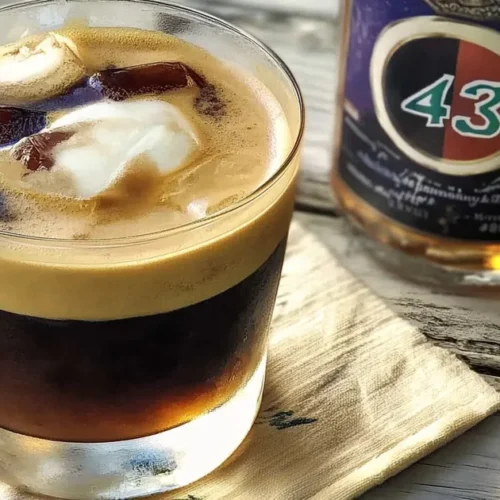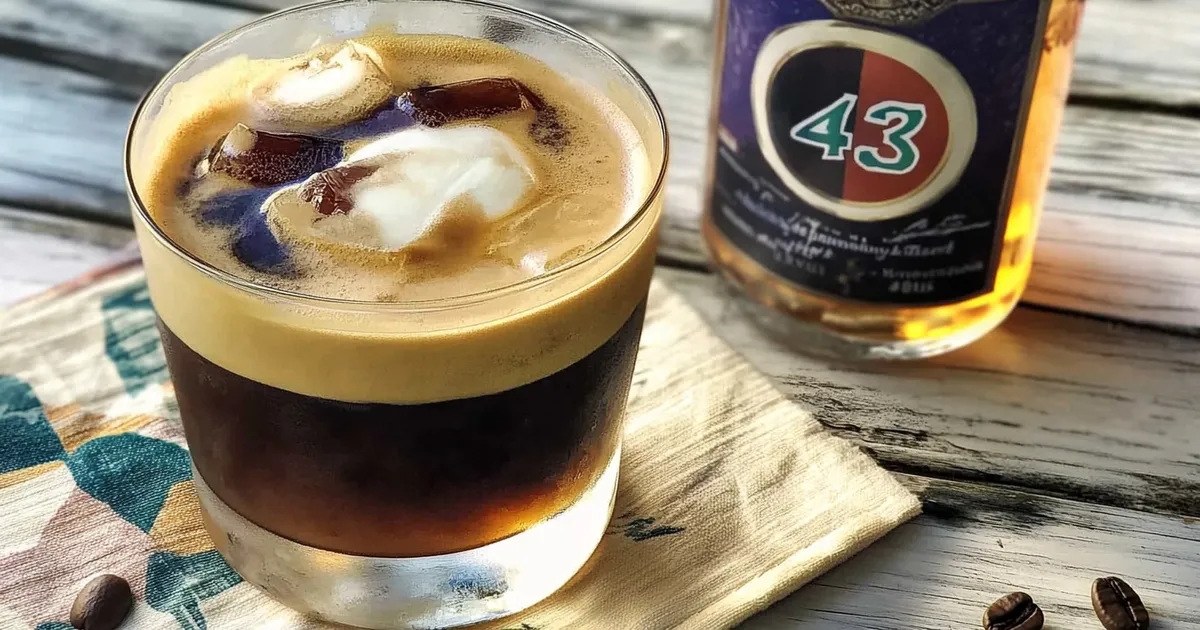The first sip of a Carajillo is an experience—bold, rich espresso blends with the smooth, spiced vanilla notes of Licor 43, creating a perfectly balanced coffee cocktail. Whether you’re indulging in it hot as an after-dinner treat or shaking it over ice for a refreshing twist, this Spanish-Mexican classic is a must-try for coffee and cocktail lovers alike.
Originating in Spain and perfected in Mexico, the Carajillo has evolved into a modern classic, served in upscale restaurants and cozy cafés alike. But what makes the perfect Carajillo? Should it be layered or shaken? And what’s the key difference between the Spanish and Mexican versions?
In this guide, we’ll break down everything you need to know—from the traditional Carajillo recipe to creative variations, expert tips, and the best food pairings. So, grab your coffee, pour a splash of liqueur, and let’s dive into the bold world of Carajillo!
Why Carajillo is the Ultimate Coffee Cocktail
What Is a Carajillo?
A carajillo is a boozy coffee cocktail that combines strong coffee (or espresso) with liquor. Traditionally, it’s made by pouring hot espresso over Licor 43, a Spanish liqueur known for its sweet, vanilla-citrus notes. However, different regions have their own twists, using brandy, rum, or whiskey instead.
Unlike an Irish Coffee, which is sweetened and layered with cream, a carajillo is usually simpler and more spirit-forward, making it a favorite after-dinner drink or an afternoon pick-me-up.
Origins and History: Spain to Mexico
The carajillo dates back to Spain, where legend has it that soldiers would mix coffee with liquor to give themselves “coraje” (Spanish for courage) before battle. The drink evolved and became a Spanish staple, especially in cities like Barcelona and Madrid.
Fast forward to today, and the Mexican carajillo has become a modern classic. Thanks to Licor 43, the drink has taken on a sweeter, creamier profile, making it a popular restaurant and bar favorite across Latin America.
Why Carajillo Has Gained Popularity Worldwide
So, why is carajillo trending? Simple—it’s:
✔ Easy to make (just two ingredients!)
✔ Versatile (can be served hot or cold)
✔ Perfectly balanced (bold espresso meets sweet, smooth liqueur)
✔ A great alternative to heavier coffee cocktails like the espresso martini
As more people explore coffee cocktails, the carajillo recipe continues to grow in popularity, especially in Mexico, Spain, and the U.S..
Classic Carajillo Recipe
Traditional Ingredients
The classic carajillo recipe is incredibly simple, requiring just a handful of ingredients. Here’s what you’ll need:
- 1 shot (1 oz) of espresso or strong coffee
- 1 ½ oz Licor 43 (or another liqueur like brandy or rum)
- Ice cubes (optional, for a cold version)
While Licor 43 is the most popular choice, some variations swap it for whiskey, brandy, or even rum, depending on regional preferences.
Step-by-Step Instructions for the Perfect Carajillo
- Brew a strong shot of espresso – The key is using bold, aromatic coffee to balance the sweetness of the liqueur.
- Choose your serving style –
- For a hot carajillo, pour the espresso into a heatproof glass.
- For a cold version, fill a glass with ice before adding the espresso.
- Add Licor 43 – Slowly pour it over the espresso, letting the flavors blend.
- Stir (or not!) – Some prefer to mix the drink, while others enjoy the layered look.
- Serve immediately and enjoy!

How to Serve Carajillo: Hot vs. Cold Variations
- Hot Carajillo – Perfect as a digestif after dinner, often served in a small glass or espresso cup.
- Cold Carajillo – A refreshing take, usually shaken with ice for a slightly frothy texture. Ideal for warm weather!
Whether hot or iced, a carajillo is smooth, bold, and slightly sweet, making it one of the best coffee cocktails you can enjoy at any time of the day!
Variations of Carajillo Recipes
Mexican Carajillo: The Licor 43 Twist
In Mexico, the carajillo has taken on a life of its own! Unlike the Spanish version (which often uses brandy), the Mexican carajillo recipe is made exclusively with Licor 43, giving it a rich, sweet, and vanilla-forward taste.
To make it:
- Use a double shot of espresso instead of a single shot.
- Shake the drink vigorously with ice, then strain it into a glass for a smooth, slightly frothy finish.
- Serve in a lowball glass, sometimes garnished with orange zest for an extra citrusy kick.
Spanish Carajillo: Brandy, Rum, and Regional Preferences
The Spanish carajillo is the original version, with a more spirit-forward approach. Depending on the region, it may be made with:
- Brandy – Adds warmth and depth.
- Rum – A Caribbean-inspired take.
- Anís or herbal liqueurs – For a more complex, aromatic drink.
It’s often served layered, meaning the coffee is poured over the liquor without mixing. This allows you to enjoy both flavors separately before they blend together!
Carajillo Affogato: A Dessert-Inspired Version
If you love coffee and ice cream, this twist is for you! The Carajillo Affogato combines:
- 1 scoop of vanilla or hazelnut gelato
- A hot shot of espresso
- 1 oz of Licor 43
Simply pour the hot coffee and Licor 43 over the gelato, and watch it melt into a creamy, boozy dessert.
Carajillo Martini: A Sophisticated Take
Want to impress your guests? The Carajillo Martini is a classy and elegant version of the drink, closer to an Espresso Martini but with a unique Spanish twist.
- 2 oz Licor 43
- 1 oz espresso
- ½ oz vodka (optional, for extra kick)
- Ice cubes
Shake all the ingredients with ice and strain into a chilled martini glass. Garnish with three coffee beans, just like a traditional espresso martini!
Key Ingredients in a Carajillo and Their Role
Espresso vs. Strong Coffee: What Works Best?
When making a carajillo recipe, the coffee choice is crucial. A strong, bold base balances the sweetness of the liqueur.
- Espresso – The best option for an authentic carajillo, delivering rich crema and deep coffee flavor.
- Cold Brew – Works well for an iced carajillo, offering low acidity and smoothness.
- French Press or Moka Pot Coffee – If you don’t have an espresso machine, these methods provide strong, concentrated coffee that complements the liqueur.
Using weak or watery coffee will result in a diluted and unbalanced drink—so always go for a bold brew!
Licor 43: The Secret to Authentic Carajillo Flavor
The star of a Mexican carajillo is Licor 43, a Spanish liqueur with vanilla, citrus, and spice notes. Here’s why it works so well:
✔ Sweetness – Balances the bitterness of the coffee.
✔ Vanilla and Citrus Notes – Enhances the natural flavors in espresso.
✔ Smooth Texture – Blends easily, whether served hot or cold.
No Licor 43? Try alternatives like Grand Marnier, Tuaca, or a mix of vanilla extract and brandy for a similar effect.
Alternative Spirits: Brandy, Rum, and Whiskey Substitutes
While Licor 43 is the most popular choice, the Spanish version of the carajillo often swaps it for:
- Brandy – Adds warmth and depth, making it a stronger, more spirit-forward drink.
- Rum – Gives the cocktail a sweeter, slightly tropical twist.
- Whiskey – Works well for a bolder, smokier variation.
Each spirit alters the final flavor profile, so pick one based on your taste preference!
Sweeteners and Additional Flavor Enhancers
Most carajillo recipes don’t need extra sugar since Licor 43 is already sweet. However, you can tweak the flavor with:
- Cinnamon or Nutmeg – Enhances warmth and spice.
- Orange or Lemon Zest – Adds a fresh citrus note.
- A Dash of Cocoa Powder – Complements the espresso beautifully.
With just a few tweaks, you can customize the carajillo to match your ideal coffee cocktail experience!
Common Mistakes When Making a Carajillo
Using Weak Coffee: Why Strength Matters
One of the biggest mistakes in a carajillo recipe is using weak coffee. Since the drink is a simple mix of two ingredients, each needs to be strong and flavorful.
Mistake: Using drip coffee or instant coffee.
Fix: Always go for espresso or strongly brewed coffee from a Moka pot or French press.
Not Balancing the Alcohol and Coffee Ratio
Another common issue is getting the ratio wrong. If you add too much liqueur, the drink becomes overly sweet. Too much coffee, and it loses its boozy kick.
The ideal balance is 1 ½ oz Licor 43 to 1 oz espresso (or a 2:1 ratio for a stronger version). If you like a boozier cocktail, increase the liqueur—but don’t let it overpower the coffee!
Overly Sweet or Bitter Carajillo: How to Fix It
- Too sweet? Add an extra shot of espresso or a pinch of cocoa powder for balance.
- Too bitter? A small amount of honey or a cinnamon stick can mellow out the flavor.
- Too strong? Add ice and shake for a smoother, lighter taste.
Choosing the Wrong Glassware for Presentation
Believe it or not, glassware makes a difference! A well-presented carajillo enhances the drinking experience.
- For a hot carajillo – Use a small heatproof glass or espresso cup.
- For an iced carajillo – A lowball or rocks glass works best.
Serving the drink in a random coffee mug? While it’ll still taste good, it won’t have the same aesthetic appeal as a properly prepared cocktail.
If you’re interested in more cocktail recipes, check out the drink selection at Urban Food Recipes for more delicious ideas!
Carajillo vs. Other Coffee Cocktails
The carajillo recipe is unique, but it’s often compared to other coffee-based cocktails. Let’s break down the differences between a carajillo, espresso martini, and Irish coffee, so you know exactly when to enjoy each one!
Carajillo vs. Espresso Martini: Key Differences
At first glance, a carajillo and an espresso martini might seem similar since both mix coffee and alcohol. However, their flavors, textures, and ingredients are quite different.
| Feature | Carajillo | Espresso Martini |
|---|---|---|
| Main Ingredients | Espresso, Licor 43 (or brandy/rum) | Espresso, vodka, coffee liqueur, sugar syrup |
| Flavor Profile | Smooth, slightly sweet, citrus-vanilla notes | Bold, rich, slightly bitter |
| Preparation | Stirred or shaken | Shaken with ice and strained |
| Texture | Light, slightly creamy if shaken | Frothy and velvety |
| Best Time to Enjoy | Afternoon or after a meal | As a sophisticated night-out cocktail |
While a carajillo is simple and warm or cold, an espresso martini is frothy, strong, and served exclusively chilled. If you’re after a refreshing, dessert-like cocktail, go for an espresso martini. If you prefer something quicker, smoother, and easier to make, the carajillo recipe is a better choice.
Carajillo vs. Irish Coffee: A Battle of Warm Drinks
The Irish coffee is another well-known coffee cocktail, but it has a completely different personality compared to a carajillo.
| Feature | Carajillo | Irish Coffee |
|---|---|---|
| Main Ingredients | Espresso + Licor 43 | Black coffee + Irish whiskey + sugar + whipped cream |
| Flavor Profile | Sweet, vanilla-citrus, bold coffee | Rich, smooth, whiskey-forward |
| Preparation | Simple mix or shaken | Layered with sugar and cream |
| Best Time to Enjoy | After lunch or dinner | Cold weather or as a holiday drink |
The main difference? Carajillo is lighter and often served cold, while Irish coffee is warm, creamy, and richer. If you love whiskey and a dessert-like finish, Irish coffee is your drink. But if you prefer something less filling, stick with the carajillo recipe!
How Does Carajillo Compare to Other Coffee-Based Cocktails?
Besides espresso martinis and Irish coffee, other popular coffee cocktails include:
- Spanish Coffee – Made with rum or brandy, sugar-rimmed glass, and whipped cream.
- Café Amaretto – Espresso with Amaretto liqueur, giving it a nutty sweetness.
- Black Russian – Vodka and coffee liqueur without the espresso.
Each drink offers a different twist on the coffee + alcohol combination, but the carajillo recipe stands out for its simplicity and balanced flavor.

Best Food Pairings with a Carajillo
A carajillo is delicious on its own, but the right food pairing can elevate your experience! Whether you’re enjoying it as a digestif, dessert companion, or part of brunch, here’s what to serve with your carajillo recipe.
Carajillo with Spanish Tapas: A Perfect Match
Since carajillo originates from Spain, it naturally pairs well with Spanish tapas. The bold coffee and citrus-vanilla notes of Licor 43 complement savory, salty snacks, such as:
✔ Jamon Ibérico – The rich, cured ham contrasts beautifully with the drink’s sweetness.
✔ Manchego Cheese – Aged Spanish cheese that enhances the vanilla notes in Licor 43.
✔ Marcona Almonds – Buttery and slightly salty, making them a great match.
For a true Spanish experience, sip your carajillo alongside a selection of cheese, olives, and toasted bread with tomato (pan con tomate).
Sweet Desserts That Complement Carajillo
Love dessert with coffee? The carajillo recipe works perfectly with rich, creamy, and chocolate-based treats. Try pairing it with:
✔ Tiramisu – The espresso in the dessert mirrors the coffee in the drink.
✔ Churros with Chocolate – A classic Mexican pairing with an indulgent touch.
✔ Flan or Crème Brûlée – The vanilla and caramel notes blend well with Licor 43.
A carajillo isn’t overly sweet, so pairing it with chocolate-based desserts enhances its flavors without overpowering them.
Savory Pairings: Cheese and Meats That Work Well
If you prefer savory over sweet, a carajillo can still be the perfect match. Here are some surprising food pairings that work well:
✔ Dark Chocolate & Sea Salt – The slight bitterness balances the sweetness of Licor 43.
✔ Aged Gouda or Parmesan – These cheeses add depth and nuttiness.
✔ Grilled Steak or Smoked Meats – The coffee and liquor flavors enhance charred, smoky dishes.
With its versatile profile, the carajillo recipe fits both light snacks and full meals, making it a great drink choice for any occasion!
Carajillo FAQs
A traditional Carajillo consists of espresso (or strong coffee) and Licor 43. Some variations use brandy, rum, or whiskey instead of Licor 43 for a different flavor profile.
Spanish Carajillo: Made with brandy, rum, or whiskey, usually served hot and layered.
Mexican Carajillo: Exclusively uses Licor 43, shaken with ice for a frothy, chilled texture.
Carajillo → Espresso + Licor 43, smooth, spirit-forward, served hot or cold.
Espresso Martini → Espresso + vodka + coffee liqueur, frothy, sweet, and served cold in a martini glass.
For a hot version, serve in a small heatproof glass or espresso cup.
For an iced Carajillo, shake it with ice and serve in a rocks glass for a smooth, chilled finish.
Yes! While Licor 43 is the classic choice, you can substitute it with brandy, dark rum, whiskey, or coffee liqueur for a unique twist.

Carajillo
Equipment
- Espresso machine or coffee maker
- Measuring jigger
- Rocks glass
Ingredients
- 1 shot Espresso or strong brewed coffee
- 1 1/2 oz Licor 43
- Ice cubes optional, for an iced version
Instructions
- Brew a fresh shot of espresso.
- Pour Licor 43 into a rocks glass.
- For a hot Carajillo, pour the espresso directly into the glass and stir.
- For a cold Carajillo, add ice cubes before pouring in the espresso, then stir well.
- Serve immediately and enjoy.
Notes
Why Carajillo Will Be Your New Favorite Coffee Cocktail
Now that you know how to make the perfect Carajillo Recipe, it’s time to enjoy this rich and bold coffee cocktail. Whether you love it smooth and layered or shaken and frothy, this drink is effortlessly delicious and perfect for any occasion.
☕ Quick Recap: Why You’ll Love This Carajillo
✔ Two ingredients, endless flavor → Just espresso and Licor 43 for a smooth, balanced taste.
✔ Hot or iced? → Enjoy it warm for a cozy nightcap or shaken over ice for a refreshing twist.
✔ Perfect pairings → Complements desserts, tapas, and even smoky meats.
✔ A coffee cocktail for any moment → Lighter than an espresso martini, but just as satisfying.
💬 Have you tried making a Carajillo at home? Do you prefer it hot and layered or cold and shaken? Drop your thoughts in the comments!
🔥 Loved this recipe? Share it with friends, pin it for later, and tag us when you make it! Let’s keep the love for coffee cocktails going! ☕🥃✨

